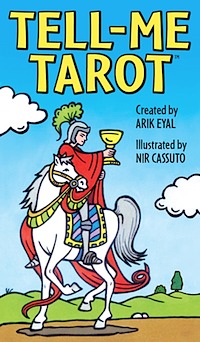By Sheri Harshberger
The Tell-Me Tarot is a delightful new Tarot published by U.S. Games Systems, Inc. It is the product of a collaboration between the creator of the deck, Arik Eyal, and illustrator Nir Cassuto. The deck is packaged to draw attention to the fact that the meanings are prominently printed on the cards.
You can't help but take notice of the artwork, both on the box and on each card. The illustrations are very appealing and colorful, as if the illustrations were intended for a children's book, but they are well-rendered and realistically portrayed, which is not the norm in children's cartoons or illustrations today. The images on each card follow the Waite-Smith tradition somewhat, but the esoteric symbolism has been removed. On first impression and based on the advertising, this deck is intended for people who are new to Tarot. None of the images or card meanings are dark or scary, which may put people who only know what they have been told about Tarot (scary or not) at ease. This is a good Tarot to use as a tool for creative writing, and dare I say, exercises in imagination. It’s also a nice deck to introduce children to Tarot, even if they don't use it like a Tarot, but as a tool for inspiration.
The deck is standard sized for a Tarot deck, and there are 78 cards consisting of the usual 22 Major Arcana and the 56 Minor Arcana. Each card in the Majors is numbered starting with The Fool at 0. Strength is numbered 8 and Justice is 11 (in Roman Numerals). The Minors, with the exception of the Courts and Aces, are also numbered with Roman Numerals. The suits used are Cups, Pentacles, Swords, and Wands. The backs of the cards are yellow suns, moons, and stars on a light sky-blue background. The backs are reversible, but there are no instructions or meanings given to accommodate reading reversals with this deck. I imagine there would be no space for the card images if the same space was allocated on each card for a reversal meaning, as each card has a phrase or two describing the meaning of the card. Additionally, there is a “+” or “-” in parentheses with the phrase to indicate whether it is good or bad. None of the cards or descriptions are worded to be bad. I believe the “+” and “-” are to be used to mitigate the overall positive or negative meaning of a reading, so rather than looking at a card as “negative,” you can look at it as detracting some of the “positive” that is being depicted. Some of the meanings aren't too bad. For example, I picked a couple of cards that are traditionally thought of as the more negative cards and here is what they have for meanings:
Three of Swords = Painful Truth (-)
You feel disappointment as you realize the truth. Now you are more aware and wiser.
Ten of Swords = Pain/Hurt (-)
Though you've been mistreated and hurt, the pain is temporary. You will soon become stronger.
Death = Termination & Renewal (doesn't have a +/- sign)
Let go of past patterns, people, or activities in order to allow renewal and personal growth.
The Devil = Fears (-)
Desires and fears could overcome you. Think positively and have faith in yourself.
The Tower = Positive Changes (+)
Unexpected breakup or destruction is required to release you from old chains and promote your growth.
I was surprised to see the Tower depicted as a positive card, although that has always been my interpretation of it. I also thought it was interesting to see no sign for Death. At first I thought that it was a typographical error, but then I noticed that there are several other cards that don't have a sign either. Some are Major Arcana, like the High Priestess, Justice, and the Hanged Man. Some are Minors, like the Knight of Swords, Six of Cups, and three of the four 2's: the Two of Swords, Pentacles, and Wands. When I referred to the instructions, I found that not having a sign is indicative of a variable meaning.
The deck doesn't come with a little white book (LWB), but rather four cards with instructions. The information provided is actually very good, and includes information on how to use the cards, when to use the cards, and what can be expected from the cards. There is also a section on how to ask questions, including the suggestion to avoid yes/no questions. Instructions are provided for one, three, and four card spreads, and diagrams for three different takes on a four-card spread are given – Time Spread, Relationship Spread, and General Spread -- which I think is great because it shows the power of a four card spread through changing the positions only.
Frankly, I was surprised by this deck. It is much deeper and interesting than I initially gave it credit for. It's not only an adequate newbie deck, but also a potential child's deck, and maybe even a deck that could intrigue someone who has been working with the Tarot for years. For a taste of something a little different, the Tell-Me Tarot is worth checking out.

